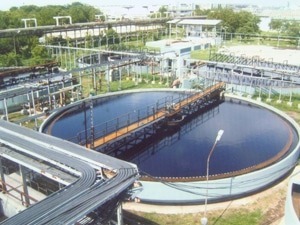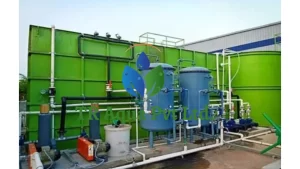Sewage Treatment Plant for Textile Industry is essential for managing the large volumes of wastewater generated during textile manufacturing processes. The textile industry is known for using substantial amounts of water, which becomes contaminated with dyes, chemicals, and other pollutants. At TR Aqua, we are a leading Sewage Treatment Plant manufacturer for Textile Industry. This treated water can be reused in the manufacturing process, reducing the consumption of fresh water and lowering operational costs.
Also Read Us: Sewage Treatment Plant for Residential Society
Work Process of Sewage Treatment Plant for Textile Industry:
The work process of a Sewage Treatment Plant (STP) in the textile industry is designed to treat and manage the wastewater generated during textile manufacturing, which is often contaminated with dyes, chemicals, and other pollutants. Here’s a detailed step-by-step explanation of how the process works:
1. Pre-Treatment
- Screening: The first step is to remove large debris such as cloth fibers, plastic, and other solid waste from the wastewater. This is done through a series of screens or filters.
- Grit Removal: Wastewater flows into a grit chamber where heavier particles like sand and gravel settle at the bottom. These particles are removed to avoid clogging equipment later in the process.
2. Primary Treatment
- Sedimentation: The wastewater is then directed to large tanks, where heavier solids (sludge) settle at the bottom due to gravity. This process helps separate solid materials from the liquid.
- Oil and Grease Removal: Lighter materials, such as oils and greases, float to the surface. These are skimmed off and removed.
- Coagulation and Flocculation (Optional): In some cases, chemicals like alum are added to help small suspended particles clump together (flocculation), making it easier to remove them.
3. Secondary Treatment (Biological Treatment)
- Aeration: In this stage, wastewater is aerated in large tanks, where air is pumped in to encourage the growth of microorganisms (bacteria). These microorganisms break down the organic pollutants in the water.
- Activated Sludge Process: In this biological process, the wastewater is mixed with activated sludge (a mixture of microorganisms) that consumes organic matter. The sludge is then separated from the treated water through settling.
- Trickling Filters (Optional): Another biological treatment method involves passing the wastewater over a bed of microorganisms (biofilm) attached to a filter media. As the water trickles over, the microorganisms break down the pollutants.
4. Tertiary Treatment (Advanced Treatment)
- Filtration: After biological treatment, the water undergoes fine filtration, often through sand filters or membrane filters, to remove any remaining suspended solids.
- Disinfection: To ensure the treated water is free from harmful pathogens, it may undergo disinfection. This can involve chlorine, ozone, or ultraviolet (UV) light to kill bacteria and other microorganisms.
- Advanced Oxidation: In cases of high contamination, such as when dyes or chemicals are present, advanced oxidation processes like ozonation or UV treatment may be used to break down complex chemicals.
5. Sludge Treatment
- Sludge Thickening: The sludge collected from primary and secondary treatment stages is thickened to remove excess water and reduce its volume.
- Anaerobic Digestion: The thickened sludge undergoes anaerobic digestion, a process where bacteria break down organic material in the absence of oxygen, reducing the volume of the sludge further.
- Dewatering: After digestion, the sludge is dewatered using techniques like centrifuges or filter presses to remove excess moisture.
- Sludge Disposal or Reuse: The final dewatered sludge can be safely disposed of in landfills, used as compost, or repurposed as an energy source, depending on its composition.
6. Effluent Disposal or Reuse
- Once the water has undergone all necessary treatment stages, it is either:
- Discharged into nearby water bodies: If it meets environmental standards set by regulatory authorities, the treated water (effluent) can be safely released into rivers or other water sources.
- Reused within the textile plant: In many cases, treated water is recycled for non-potable purposes such as washing, cooling, or other industrial processes within the textile plant.
- Discharged into nearby water bodies: If it meets environmental standards set by regulatory authorities, the treated water (effluent) can be safely released into rivers or other water sources.
Conclusion:
Get the best quality sewage treatment plant for Textile Industry at cost effective pricing, wherever in India. By using a combination of physical, biological, and chemical treatments, the STP ensures that wastewater is treated to meet regulatory standards and can be either safely discharged or reused within the facility. TR Aqua, the best sewage treatment plant manufacturer in India is here to provide you the quality based product.



